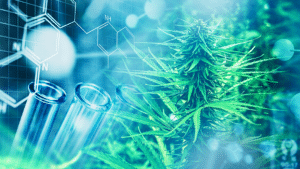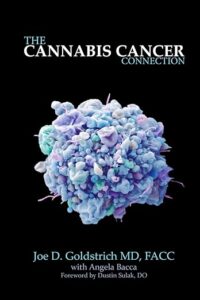As an Amazon Associate I earn from qualifying purchases.

Adapted from The Cannabis Cancer Connection: How to use cannabis and hemp to kill cancer cells by Joe D. Goldstrich, MD, with Angela Bacca (Flower Valley Press, 2023).

There is a growing body of anecdotal and scientific evidence that the “major cannabinoids” tetrahydrocannabinol (THC) and cannabidiol (CBD), certain “minor cannabinoids” (some without a name), and other cannabis compounds have antineoplastic action against cancer cells.
The vast majority of the existing research is on how specific cannabinoids kill cancer, but a growing body of work is revealing how the entourage of compounds found in whole-plant cannabis kills cancer.
Although most of the studies presented here demonstrated the antineoplastic effects of individual or isolated cannabinoids, most of this research points to what lay healers and patients who make and use their own cannabis oil already know: the whole cannabis plant, including hemp varieties, every part of them, contain antineoplastic compounds that together kill cancer.
How THC Kills Cancer
Until relatively recently, almost all medical studies about cannabis have been specifically on THC, as is most of the preclinical research showing the antineoplastic activity of cannabis. With a few exceptions, tumor cells throughout the body have cannabinoid receptors on their surface, and THC can bind to these receptors and induce apoptosis or programmed cell death. Put simply, when THC binds to the cancer cell, it forces the cancer cell to commit suicide.
In addition to inducing apoptosis when binding to a cancer cell, THC may also help relieve pain. THC binds to two types of cannabinoid receptors, CB1 and CB2. CB1 receptors are found in the brain and all the major organs in the body. Pain impulses are reduced when THC binds to CB1 receptors in nerves carrying painful impulses back to the brain.
The second receptor to which THC binds is CB2. CB2 receptors are found in the digestive and immune system, and specifically on many tumors, especially malignancies related to the immune system like leukemias and lymphomas. Many tumors contain both CB1 and CB2 receptors.
Interestingly, many tumors with a high level of malignancy and a tendency to metastasize have high levels of cannabinoid receptors, making them particularly vulnerable to cannabinoid-induced apoptosis. Either CB1, CB2, or both must be present in the tumor cells for THC to induce apoptosis in the tumor.1-3
THC and CBD also limit tumor growth by blocking the production of vascular endothelial growth factor, which stimulates the growth of new blood vessels needed for cancer to grow. Without increased blood flow, the tumor does not have enough nutrition to sustain its development.4,5
How CBD Kills Cancer
CBD exhibits apoptotic, anti-proliferative, and anti-invasive activity.6,7 Although CBD does not bind directly to the CB1 or CB2 receptors, it also has a powerful antineoplastic effect. CBD’s presence weakens THC’s binding to the CB1 receptor and may mitigate undesirable psychoactivity caused by THC.
CBD produces its anticancer effect in several ways. Perhaps most intriguing is the downregulation of the ID-1 gene. ID-1 is a normal gene highly expressed in newborns and young children. It stimulates the growth and development of cells, tissues, and organs needed in early development. There is little need for this in adulthood, and ID-1 activity in normal cells becomes minimal or nonexistent as humans grow older. However, cancer cells can reactivate this dormant gene and use it to promote their growth. ID-1 not only encourages the growth of cancer cells, it also increases their survival. ID-1 also facilitates cancer’s ability to metastasize while protecting it from chemotherapeutic agents.8-12
CBD has been shown to help turn off ID-1 by downregulating its tumor expression. Like THC, CBD limits tumor growth by blocking the production of vascular endothelial growth factor. CBD has also been shown to inhibit cancer cell migration and metastases by preventing cancer cells from adhering to other tissues.
Combining THC, CBD & CBG
Despite the powerful antineoplastic activity of all these cannabinoids individually, very little research has been done to show their combined effects on cancer. However, initial studies have shown that combining THC and CBD can be effective against melanoma skin cancer cells and multiple myeloma cell lines.13,14
More promising, however, is a study conducted by St. George’s University of London, which demonstrated that CBD was almost twice as powerful as THC in its ability to kill leukemia cells in a particular cell line. When THC and CBD were combined, the effect was twice as strong as CBD alone.
These researchers also experimented with a second type of leukemia cell and found that the magnitude of the cell death with THC and CBD combined was less than with the first cell type, but still showed these cannabinoids were more powerful together than alone.
They also tested combinations of CBD and THC with cannabigerol (CBG). Once again, the combinations were consistently more powerful than individual cannabinoids alone. CBD plus CBG proved to be an especially potent combination on one of the cell lines. CBD plus CBG also improved outcomes when paired with one type of chemotherapy. When used with another chemotherapy, CBD with CBG was counterproductive.
Finally, they demonstrated that when THC and CBD are combined with chemotherapy, the timing of the administration of these agents makes a crucial difference in the death of cancer cells. There was more cancer cell death when the cannabinoids were administered after the chemotherapy than before it.
Both CBD and THC can affect the metabolic breakdown of many chemotherapeutic drugs. Drug interactions can increase toxicity from chemotherapy by boosting blood drug levels of chemotherapeutic agents. I advise my patients to stop using cannabis for 36 to 48 hours prior to chemotherapy and to start again 36 to 48 hours after their session. (See chapter: Using Cannabis Oil with Traditional Cancer Therapies).
THC & CBD (Sativex®) with Temozolomide: A Phase 2 Study
Before a drug can be submitted for FDA approval, it must undergo three testing phases. Phase 2 is the first study level conducted on patients with the disease for which the drug is intended and determines whether it is safe and effective.
United Kingdom-based GW Pharmaceuticals has produced the world’s first approved cannabis-based medicines for the UK, US, and European markets, Sativex® and Epidiolex®. Epidiolex is a high-CBD tincture, and Sativex® has a roughly 1:1 ratio of THC and CBD. As part of the approval process for all markets, they have conducted critical Phase 2 studies on various conditions, including cancer.
GW Pharmaceuticals’ research on glioblastoma multiforme (GBM) is important and promising. They conducted a double-blind, placebo-controlled phase 2 clinical trial using Sativex® in conjunction with temozolomide to treat recurrent glioblastoma multiforme (GBM). GBM is a highly aggressive brain tumor with a very poor prognosis. There is no consistently successful pharmaceutical drug therapy available to treat it, and while temozolomide is one of the best pharmaceuticals currently used, efficacy on its own is sorely lacking.
Twenty-one patients with recurrent GBM received a maximum of 12 sprays of Sativex® daily, plus temozolomide. Compared to the placebo group only receiving temozolomide, 83% of the patients treated with Sativex® lived for at least one year, while only 53% of the patients in the placebo group lived that long. The median survival for the group taking the Sativex® and temozolomide combination was greater than 550 days compared with 369 days for the placebo group.
Twelve sprays of Sativex® daily (the maximum dose administered in this study) equals 32.4 mg of THC and 30 mg of CBD. Although this is a far cry from the “gram a day” many patients use on their own and much lower than the doses usually recommended in cancer treatment, especially for highly malignant tumors like GBM, these remarkably low doses are encouraging. This study also speaks to the potential benefits of combining cannabinoids with chemotherapy to achieve results neither might achieve on their own.
[Note: In May 2021, GW Pharmaceuticals was acquired by Jazz Pharmaceuticals.]
How CBG Kills Cancer
CBG has demonstrated antineoplastic activity and inhibits the growth of colorectal cancer cells primarily by inducing apoptosis. It also increases reactive oxygen species (ROS), a mechanism THC and CBD use to kill cancer cells. Destroying cancer cells via the ROS mechanism means that CBG, like THC and CBD, oxidizes the cancer cells. Taking antioxidant supplements while using cannabis as an antineoplastic agent may be counterproductive. (See chapter: Nutritional Supplements & Antioxidants).
Israeli scientist Dedi Meiri has also demonstrated the antineoplastic activity of CBG against a wide variety of cancers. In experiments with 12 cancer cell lines, Meiri showed that CBG demonstrated significant cancer-killing activity against six of them.
Other preclinical research has shown that when CBG is combined with other cannabinoids, antineoplastic activity is enhanced in both glioblastoma and breast cancer cells.15,16
The Earliest Research Shows CBN Kills Cancer
Cannabinol (CBN) was one of the cannabinoids found initially to be antineoplastic in experiments conducted as early as 1975. There have only been a few publications demonstrating the antineoplastic effects of CBN since then. A more recent study has shown that a combination of THC, CBD, CBG, and CBN have the most powerful antineoplastic activity against estrogen-positive breast cancer cells.
A Promising Look at CBC
A recent preprint (not yet peer-reviewed) publication from Israel showed that the most potent antineoplastic cannabinoid combination for killing ovarian cancer cells was THC, CBG, and cannabichromene (CBC). This research was expedited and published as a preprint because ovarian cancer is so aggressive and lethal that they wanted to get the information in the public domain as soon as possible.
Another 2021 research publication from Israel showed that when CBC was paired with either CBD or THC, it “led to cell cycle arrest and cell apoptosis” against bladder urothelial carcinoma (UC), the most common urinary system cancer. Combining CBC with THC or CBD also inhibited cell migration (metastasis).
While these studies are promising, it is a challenge to incorporate significant amounts of CBC into full-spectrum cannabis protocols because CBC is present in such low quantities in both hemp and cannabis cultivars. Until CBC is bred higher in the plant through natural methods, highly concentrated CBC products are likely a result of synthetic processes, such as those used to produce Δ8-THC. I do not recommend these synthetic products to cancer patients because of their potential toxicity. (See chapter: Cannabinoids, Terpenes & Flavonoids).
Other Promising Cannabinoids
Research conducted by Dedi Meiri has shown that many other so-called “minor“ cannabinoids, some yet even to be named, have antineoplastic activity. The two most researched cannabinoids found in very low concentrations in some cultivars that demonstrate antineoplastic activity are tetrahydrocannabivarin (THCV) and cannabidivarin (CBDV). Another cannabinoid identified by Meiri, currently identified only by a number 331-18B, has also shown significant antineoplastic activity. Because the concentrations of these cannabinoids vary so widely between cultivars, using multiple varieties of THC-rich cannabis to prepare therapeutic oil will increase the likelihood of incorporating these desired cannabinoids.
The Acid (Raw) Cannabinoids
Acid cannabinoids are found in large quantities in “raw” (unheated) plant material. When heated, THCA, CBDA, CBGA, and other acid cannabinoids are converted into THC, CBD, and CBG, respectively.
In a 2016 study, tetrahydrocanabinolic acid (THCA) was shown to be effective in inhibiting the growth of two different human breast cancer cell lines; triple-negative breast cancer and HER2-positive breast cancer, which is considered to be the most treatment-resistant of all breast cancers. However, investigators were unable to determine exactly how THCA achieved anti-neoplasia.
Research from Meiri’s lab has shown that for some prostate cancer cells, THCA is the most antineoplastic cannabinoid.
Two Japanese studies exploring the actions of cannabidiolic acid (CBDA) against one cell line of breast cancer showed that CBDA was able to limit the ability of these cells to migrate, meaning it may limit the ability of cancer cells to metastasize. The researchers estimated that this same mechanism would apply to approximately 40% of invasive breast cancers in humans. They uncovered a possible mechanism of action in the second published research paper.17,18
Preclinical studies have shown that extracts of cannabis with high content of both CBDA and cannabigerolic acid (CBGA) inhibit aldose reductase, an enzyme involved in inflammation and cancer growth.19,20
CBGA and THCA each act independently as antineoplastic agents when used against precancerous adenomatous polyps and colon cancer cells. When used in combination, the antineoplastic effect is even stronger.
A Patent for Combined CBGA & CBDA to Kill Cancer
GW Pharmaceuticals was awarded a patent in 2018 by the US Patent and Trademark Office for the use of CBGA and CBDA to kill cancer. This action indicates they likely have independent and proprietary research establishing some efficacy. It is important to note that they mention cannabinoids are more effective when used in combination instead of being used alone. The patent reads:
“The present invention relates to an active pharmaceutical ingredient (API) which comprises or consists essentially of cannabidiol (CBD) and one other cannabinoid selected from cannabigerol (CBG), cannabigerolic-acid (CBGA), cannabidiolic-acid (CBDA), and tetrahydrocannabivarin (THCV) for use as a medicament, and more particularly, for use in the treatment of cancer. These combinations have shown themselves to be synergistic in treating one or more of: breast cancer; liver cancer; lung cancer; pancreatic cancer; melanoma; ovarian cancer; gastric cancer; renal cancer or bladder cancer. Two particularly favored API combinations are: cannabidiol (CBD) and cannabigerol (CBG); and cannabidiolic (CBDA) and tetrahydrocannabivarin (THCV).”
Terpenes
More than 200 terpenes have been identified in the cannabis plant, and some have demonstrated antineoplastic activity. In a brilliant review of cannabis pharmacology, Ethan Russo, MD et al. described antineoplastic activity for the following terpenes found in the cannabis plant: limonene, ɑ-terpineol, linalool, camphene, humulene (ɑ-caryophyllene), β-elemene, guaiol, and eudesmol.
However, one experiment failed to show benefits when humulene and linalool were added to pure THC.
Flavonoids
So far, only one flavonoid found only in the cannabis plant has been shown to kill cancer cells.
In 2019, researchers from the Brigham and Women’s Hospital, Dana-Farber Cancer Institute, Harvard Medical School, and the University of Massachusetts found that a derivative of Cannflavin B, FBL-03G, “demonstrates significant therapy potential in the treatment of pancreatic cancer, including radio-sensitizing and cancer metastasis treatment potential.”
Several other flavonoids found in cannabis (and other plants) have also demonstrated antineoplastic activity.21,22 (See chapter: Cannabinoids, Terpenes & Flavonoids).
Joe D. Goldstrich, MD, FACC, is a retired cardiologist who has studied and explored unconventional medical approaches to wellness throughout his six-decade career. Angela Bacca has authored hundreds of articles and edited and/or co-authored over a dozen books as well as edited various online and print cannabis-centric publications. The Cannabis Cancer Connection is published as an ebook and paperback.
Footnotes
- https://www.ncbi.nlm.nih.gov/pmc/articles/PMC4171598/
- https://tinyurl.com/pb8uxfes
- https://www.ncbi.nlm.nih.gov/pmc/articles/PMC6352507/
- https://tinyurl.com/5cnm4uee
- https://bpspubs.onlinelibrary.wiley.com/doi/pdf/10.1111/j.1476-5381.2012.02050.x
- https://www.sciencedirect.com/science/article/abs/pii/S0301468109602358
- https://www.mdpi.com/1422-0067/20/23/5905/htm
- https://www.ncbi.nlm.nih.gov/gene/3397#top
- https://biosignaling.biomedcentral.com/articles/10.1186/s12964-016-0161-y
- https://tinyurl.com/bdznbdu3
- https://www.ncbi.nlm.nih.gov/pmc/articles/PMC3410650/
- https://www.jidonline.org/article/S0022-202X(15)37287-0/fulltext
- https://www.jidonline.org/article/S0022-202X(15)37287-0/fulltext
- https://www.ncbi.nlm.nih.gov/pmc/articles/PMC5363603/
- https://www.ncbi.nlm.nih.gov/pmc/articles/PMC7587381/
- https://www.ncbi.nlm.nih.gov/pmc/articles/PMC7914500/
- https://www.ncbi.nlm.nih.gov/pmc/articles/PMC4009504/
- https://link.springer.com/article/10.1007/s11418-016-1030-0
- https://www.ncbi.nlm.nih.gov/pmc/articles/PMC3142792/
- https://tinyurl.com/2r83bpun
- https://pubmed.ncbi.nlm.nih.gov/16097445/
- https://pubs.acs.org/doi/pdf/10.1021/acsomega.1c00318
The post The Cannabis Cancer Connection appeared first on Project CBD.
Amazon and the Amazon logo are trademarks of Amazon.com, Inc, or its affiliates.

